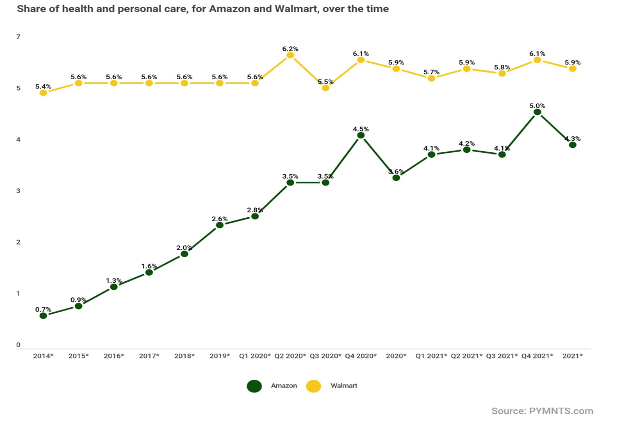
The contest between Walmart and Amazon for supremacy in the vast health and personal care category is narrowing and heating up.
As PYMNTS exclusive market share research reflects in the chart below, Walmart’s lead in this segment — its second largest source of revenue behind food and beverage — has steadily shrunk over the past decade, falling from an 8x lead in 2014, to just a 1.5 percentage point margin as of the end of 2021.
Where Amazon has consistently gained market share over the years in the sale of health products, Walmart has essentially been treading water on that front. Although PYMNTS estimates the Arkansas-based chain’s share of U.S. retail activity, both online and in-store, was unchanged from a year ago at 5.9%, its rival’s slice of the domestic pie improved to 4.3% from 3.6% in 2020.

What this chart doesn’t show that is also telling, however, is that “treading water” in Walmart’s case was achieved by growing its underlying sales of health and personal care products by 30% over the past fast years.
By that monetary measure, Walmart’s roughly $50 billion haul is still about a third larger than Amazon’s $36 billion tally which was in single-digit billions not that long ago.
It’s a bit like catching a falling knife because if Walmart is keeping its share, then Amazon must be taking it from someone else — at least partially — which points to the multilateral competition with grocery stores, other retailers such as Target, as well as the rise of aggregators and D2C sites.
Suffice to say, health is a vast, important and growing category for both players, and each is committed to not only growing product sales but also to adding share and fueling the funnel via expansion into medical services and prescriptions and more. That said, the ultimate winner of this fight will likely end up being the consumer.
When One Alexa Isn’t Enough
Although PYMNTS data show that roughly one-third of U.S. households currently own a voice-activated device or smart speaker, that implies that two-thirds of American homes are missing out on the fun.
While Amazon has an estimated 70% stake of the existing market, it moved this week to grow that category, not just by attracting first time voice-command users, but by appealing to existing ones too.
In short, if “a chicken in every pot” was good enough for depression-era economics, then “an Alexa in every room” is at the core of this week’s pitch.
Read more: Amazon Leans on Alexa to Connect With ‘All Aspects of Consumers’ Lives’
“As I was lying there on the floor, I ran through my options. My cell phone wasn’t within reach and I wasn’t sure I could move to get it,” Amazon user “Penny” recounted in the company’s recent blog post. “Then I remembered Alexa. We have Echo devices all over the house,” she added, before describing how she was able to use the voice-activated device to contact a neighbor to help her after being injured in an unexpected fall.
On the one hand, the safety and security appeal of being able to “call for help” is clearly aimed at seniors and housebound individuals (or their caregivers) who might be less technologically inclined. On the other hand, the “Alexa in every room” campaign that is aimed at existing users is designed to scale device ownership throughout the house.
Why only have Alexa listening in the kitchen when it could also be standing by to serve you in the bedroom, bath or den?
While that notion may gain traction in certain circles, the privacy implications of whole-house eavesdropping would likely be a harder sell for many consumers. That said, the trajectory and number of use cases for voice-activated devices is on the rise, and Amazon is well-positioned to capitalize on that trend.
A Day in Court
There is nothing unusual about huge, multinational companies being sued or filing suit and yet this past week both Amazon and Walmart were in the news for courtroom action, albeit on different sides of the docket.
In the former, defendant Amazon prevailed — at least momentarily — in its antitrust fight versus the city of Washington, D.C. when a Superior Court judge dismissed the suit that alleged the online retailer took part in anti-competitive practices by forbidding merchants to sell their products for a lower price elsewhere.
Amazon argued the practice was widely used in the industry and in the best interests of consumers. The city’s attorney said otherwise, pointed to other pending litigation and federal suits, and indicated that an appeal was likely.
In the latter matter, plaintiff Walmart took action against warehouse club BJ’s Wholesale over allegations that it copied its Scan & Go mobile self-checkout technology without permission. The federal patent infringement suit alleges that the tech it developed and deployed at its Sam’s Club stores was copied by its rival’s ExpressPay feature which was rolled out last year.
The fight comes at a time when Amazon is actively expanding its own basket of touchless checkout systems, including its Just Walk Out and palm scanning platforms it is using in its own stores and licensing to other retailers as well.